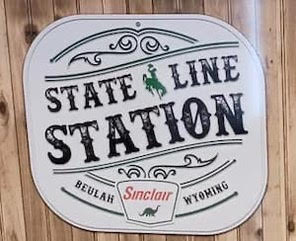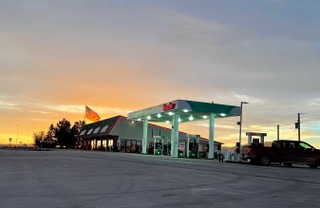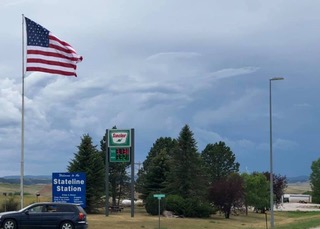State Line Station Transition Can Be Electric

20 Oct 2021
News
As an owner of a consulting company focused on small businesses, David Cromes knows first impressions are critical. As the new owner of the State Line Station in Beulah, Wyoming, the first gas station and convenience store travelers encounter entering the state on I-90, he sees an opportunity to make an immediate impact on those visitors.
“There is a national image of Wyoming, in regards to energy production, as being nothing but dirty coal and oil fields,” he said. “But the state is heavy into renewables and we have an incredible opportunity here to educate the country on what Wyoming truly is.”
For Cromes, that opportunity involves the ability to bring more electrical vehicle charging options to northeast Wyoming, starting with his station. As the popularity of electric vehicles increases, the demand for locations to quickly charge those vehicles will increase. But Wyoming has very few of such stations, especially in his area.
Electric vehicle charging was not on Cromes’ radar when he purchased the State Line Station in February 2021. Cromes has more than 20 years of experience with the U.S. Navy and in the defense industry. He is the founder of and principal advisor with Illustra Advisory, a consulting business providing advice and coaching in professional business best practices. His wife, Janie Hett, is a doctor of physical therapy and founder and owner of Peak Motion Physical Therapy. The COVID-19 pandemic had an incredible impact on both of their businesses, each suffering an extraordinary loss of revenue. Both businesses have recovered, but the experience led them to look for something else.
“We thought we were fairly diversified, but learned we were not COVID-proof,” said Cromes. “That led us to the gas station.”
Living in Beulah, Cromes was familiar with the station. It had focused heavily on summer tourists, hunters and Interstate travelers, benefiting largely from a “last gas for 20 miles” business model. Cromes’ initial business plan was to cater more to the needs of the local community, offering fresh produce, meats, dairy, and a greater breadth of groceries.
“While you cannot take your eye off the ball of meeting summer tourist needs, I felt we could provide more for the locals,” said Cromes. “If you care for the community, they will care right back for you.”
Electric Vehicles
That one eye on tourism has led Cromes to the potential for electric vehicles (EV) and their charging requirements. The Guardian reported that global sales of electric cars accelerated fast in 2020, rising by 43% to more than 3 million, despite overall car sales slumping by a fifth during the coronavirus pandemic. In the U.S., EV sales were slower, but largely due to the lack of a charging infrastructure outside of major metropolitan areas.
 Level 1 or Level 2 Charging Stations are common in homes or public locations, but are not conducive to long distance traveling. Level 1 stations offer up to 10 miles per hour of charge, while Level 2 stations can more than double that range. Level 3, or DC Fast Charger, stations can bring a car to full charge in 20-40 minutes. There is not one Level 3 Charging Station in eastern Wyoming, however. A Tesla Supercharger is eight miles away in Spearfish, but they are currently unavailable to other electric vehicles. That ability to charge quickly is the difference between tourists coming to northeastern Wyoming or diverting their travel plans elsewhere. Therefore, the opportunity to install a Level 3 Station is a tremendous opportunity for the area, said Cromes.
Level 1 or Level 2 Charging Stations are common in homes or public locations, but are not conducive to long distance traveling. Level 1 stations offer up to 10 miles per hour of charge, while Level 2 stations can more than double that range. Level 3, or DC Fast Charger, stations can bring a car to full charge in 20-40 minutes. There is not one Level 3 Charging Station in eastern Wyoming, however. A Tesla Supercharger is eight miles away in Spearfish, but they are currently unavailable to other electric vehicles. That ability to charge quickly is the difference between tourists coming to northeastern Wyoming or diverting their travel plans elsewhere. Therefore, the opportunity to install a Level 3 Station is a tremendous opportunity for the area, said Cromes.
“We have the opportunity to show how Wyoming can be a shining example of how to leverage renewables, expand on distributed power generation and provide an EV charging infrastructure all at once,” he said. “Wyoming is doing just as much in renewable energy as any other state in the country.”
One example is Cromes’ energy provider, Powder River Energy Corporation (PRECorp). Centered in northeastern Wyoming, it sources approximately 30% of its power from green and renewable sources. Still, that opportunity is not as simple as purchasing and installing the station for Cromes or PRECorp. To begin, the cost to purchase and install a single Level 3 Charging Station can be between $100,000 and $250,000. In addition, they require DC power, while Level 2 and below only require AC. Converting and storing DC power on-site would require additional substantial investment, and coordinating with the local power supplier to provide 3-phase power. This also presents a unique opportunity to leverage distributed power generation such as solar or wind, which initially generates DC power which must typically be converted to AC for home use.
“With our property’s south-facing hillside and generally windy location, we are in a wonderful position to install a large solar array or even erect a small wind generator to generate power close to the dump point,” he said. “Every bit of locally generated DC power saves power and money over converting 3-phase AC to DC on site.”
 That possibility brought Cromes to work with PRECorp on discussions around that scenario. They agreed it would be an act of futility to go too far down the path while the U.S. government was debating the largest infrastructure bill ever. That American Jobs Plan includes a vision to build a national network of 500,000 charging stations.
That possibility brought Cromes to work with PRECorp on discussions around that scenario. They agreed it would be an act of futility to go too far down the path while the U.S. government was debating the largest infrastructure bill ever. That American Jobs Plan includes a vision to build a national network of 500,000 charging stations.
“We want to understand what actually gets passed to determine how we could proceed,” said Cromes. “We want to be in position on Day One to apply for any federal funding available because we want to be ready to lead the charge.”
To make the vision reality in Wyoming, then, would require cooperation from a series of entities, like the Wyoming Governor’s Office and the Wyoming Business Council, to electrical generators and distributors like PRECorp. The distribution system for petroleum fueled cars has been determined for years, but ‘fueling’ the growing EV market still requires considerable study, especially in how to effectively ‘retail’ power to traveling consumers.
“Everyone is trying to figure this out, from significant issues like providing DC power locally, to unique features such as branding the power itself,” said Cromes. “I sell Sinclair fuel at the station; whose power would I sell, and would those entities want to enter branding relationships much like the oil industry?”
So what began as a way to provide more groceries and supplies for residents at the convenience store has now become something much, much bigger.
“We are pleased we are surviving this first year of owning the business, but we feel we can provide a greater solution for an even larger community,” said Cromes.
More Topics









